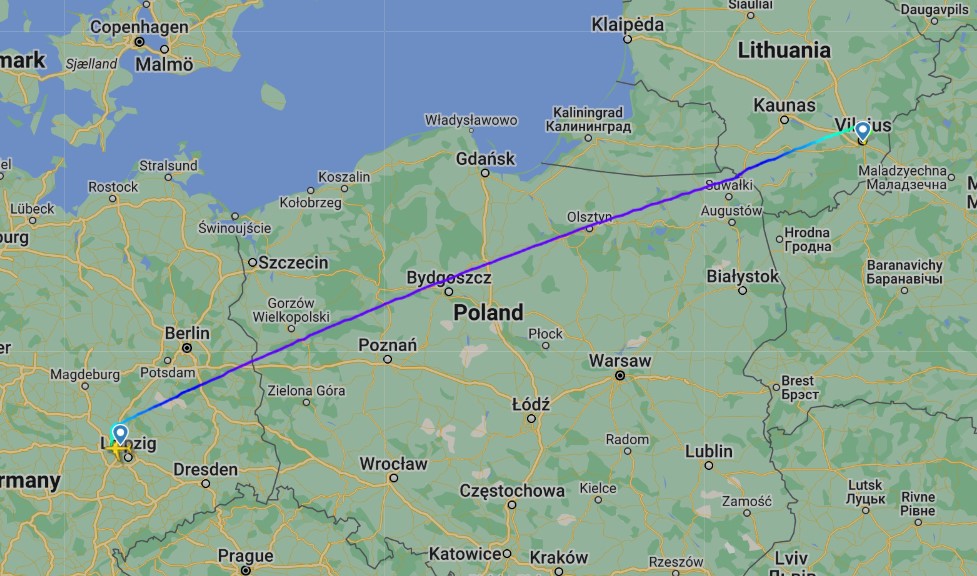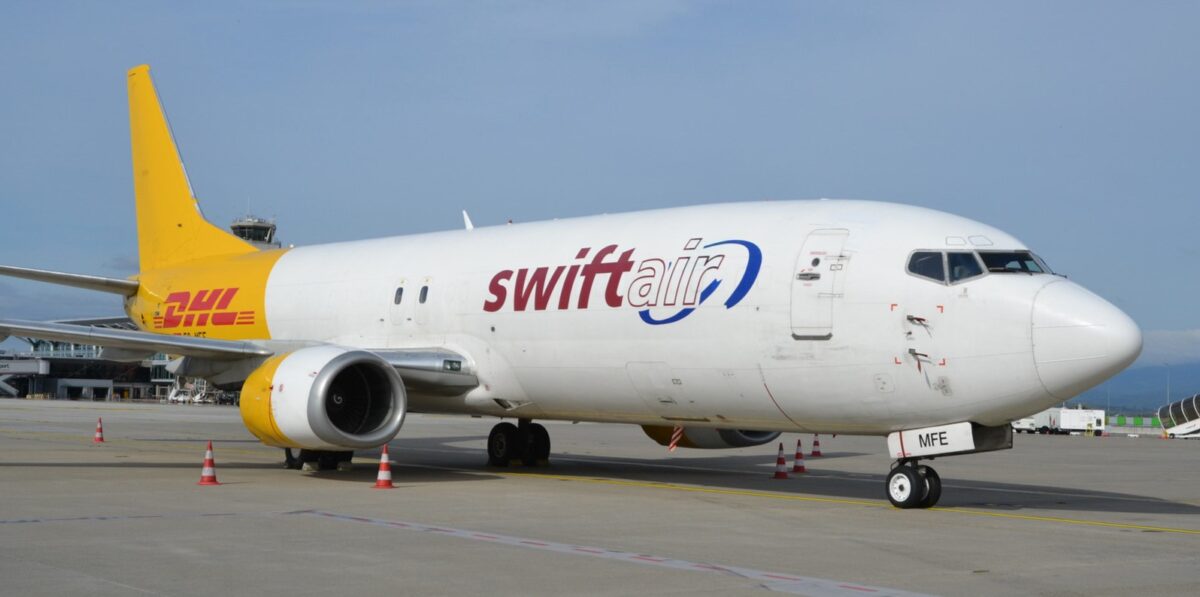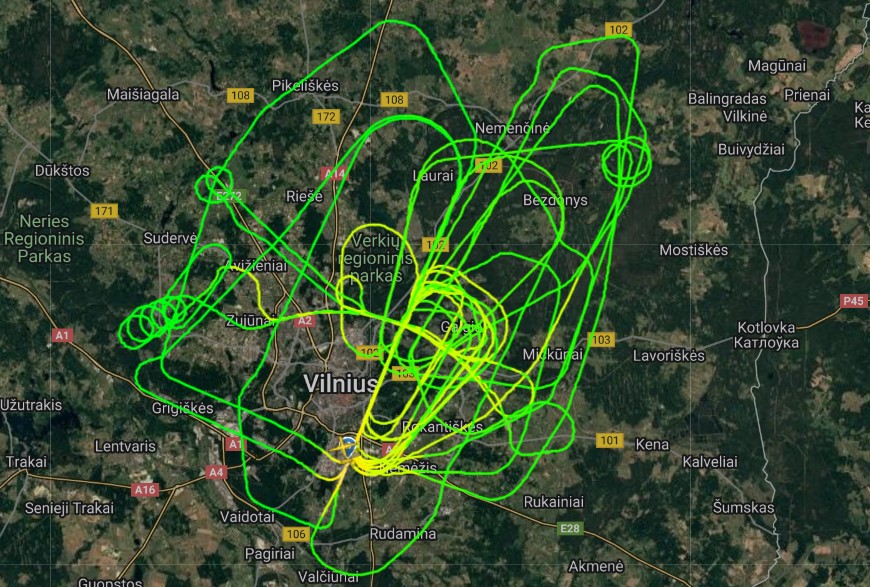On the morning of November 25. 2024, a Boeing 737-400 freighter operated by Swiftair of Spain on behalf of global logistics giant DHL crashed on final approach into Vilnius Airport (VNO) in Lithuania, the aircraft’s intended destination. In this article, AeroTime summarizes what we know so far about the incident, and what aspects of the flight the authorities are likely to be focusing on as part of their investigation.
The flight involved was a routine DHL Express service from its European central logistics hub at Leipzig/Halle Airport (LEJ) in Germany to the Lithuanian capital city of Vilnius. The service, operating with flight number BCS18D, operates four nights per week using Boeing 737-400 freighter aircraft.
The aircraft involved in the Vilnius incident was operated by Spanish all-cargo airline Swiftair under contract to DHL. The aircraft, registered EC-MFE, was 31.1 years old, having first been delivered as a passenger plane to now-defunct carrier Australian Airlines in October 1993 and was later operated by Qantas. The aircraft was converted into an all-cargo variant in 2014 and was delivered to Swiftair in February 2015.
In the week leading up to the incident in Vilnius, the aircraft had operated multiple sectors, paying visits to various European airports including Cologne, Amsterdam, Dublin, Brussels, Bologna, Skopje, Athens, Barcelona, and Milan. Onboard the incident flight was two pilots of Spanish origin, plus two DHL employees – one German citizen plus one Lithuanian citizen. It has been confirmed that one of the pilots lost their life as a result of the incident while the three other survivors were taken to hospital with serious injuries.
Analysis of the flight
Reviewing the flight data obtained from the aviation data website Flightrardar24 shows that flight BCS18D departed Leipzig at 03:08 local time for the one-hour and 20-minute flight to Vilnius. The was 32 minutes ahead of its scheduled departure time of 03:40. The flight was due to arrive in Vilnius at around 05:30 local time.
After departure from Leipzig’s runway 26L, the aircraft headed north and then eastwards, climbing to 33,000ft (10,300m) and crossing the German/Polish border at 03:26, around 18 minutes after take-off. The flight proceeded in an easterly direction and passed into Lithuanian airspace at 05:11 local time. The flight then began its descent into Vilnius and passed to the north of the city on a right-hand downwind approach for its landing on runway 19 at Vilnius Airport.
The flight turned right for its final approach at 05:25 descending below 5,000ft and established on its final approach to the airport. At this late stage, all appeared normal with the aircraft seemingly in the correct profile for landing on runway 19 and telling ATC it was established on the ILS (Instrument Landing System) for runway 19. However, having descended to 650ft (200m) and traveling at around 150 knots, the flight data comes to an abrupt stop.
DHL B737-476(SF) cargo plane crash near Vilnius Airport (VNO), Lithuania shows no issues reported by the pilots before the terrain impact, according to Lithuanian officials.
The aircraft was carrying out flight QY5960 from Leipzig to Vilnius and the accident took place while… https://t.co/KKmGJjzwUR pic.twitter.com/Lw1suxfAtK
— FL360aero (@fl360aero) November 25, 2024
Video evidence seen by AeroTime shows the aircraft fully established for its landing, with little sign of any anomaly. The aircraft passes over the suburb of Liepkalnis Hill less than a mile from touchdown at that point. It then appears to suddenly pitch violently nose-up before it disappears from view before a large post-impact fire becomes visible.
What we know so far
According to local media reports, the official cause of this incident is currently under investigation. However, air traffic control (ATC) at Vilnius Airport had been in contact with the crew of BCS18D throughout its final approach. While ATC had transmitted a landing clearance to the crew of BCS18D, no meaningful response was received, although some sounds were heard on the frequency consistent with an aircraft impacting the ground.
According to a report by Lithuanian media outlet LRT, the Boeing 737 crashed close to residential buildings, resulting in a two-story building catching fire. A representative from the Vilnius Fire Protection and Rescue Department (PAGD) informed LRT Radio that at least four people were onboard, including two pilots and two passengers, and that one of the pilots had died as a result of injuries sustained.
Vilnius Mayor Valdas Benkunskas declared an emergency following the crash. He said: “We will urgently declare an emergency situation in the area to ensure the rapid liquidation of the consequences of the accident – cleaning up the territory, and collecting harmful materials.”
Investigation underway
Lithuania’s National Crisis Management Centre deployed experts to the site to investigate the accident soon after it happened. Given that the flight had seemingly passed uneventfully and was on schedule as it approached Vilnius Airport, authorities are examining exactly what happened onboard the plane during the final moments of its approach into Vilnius Airport.
The video below appears to give no clear sign of anything wrong with the aircraft itself, with no mechanical or technical defect seemingly evident. Poor weather conditions do not appear to be a factor. The 737 can be seen on short finals for runway 19 before some catastrophic event occurs just a few hundred meters from the runway threshold.
CCTV captured the crash of the Boeing 737-300SF on approach to Vilnius:pic.twitter.com/GG1j7HWeuk
— Aviation Safety Network (ASN) (@AviationSafety) November 25, 2024
A potential loss of control or pilot error could both be possible contenders for the primary cause of the accident. The sudden nose-up attitude could indicate the onset of a stall, for example, a recovery from which at such a low altitude would be impossible. However, it is understood by AeroTime that another line of inquiry is being investigated.
Sources have told AeroTime that the aircraft had possibly descended below the glidepath for runway 19 in its final moments and may have struck the ground (with the nose pitching up being the pilots attempting to avoid impacting the ground). This phenomenon is termed as Controlled Flight Into Terrain (or CFIT) by the aviation industry.
Seeming to support this theory, on the day of the accident, the Lithuanian authorities brought in a Polish Air Navigation Services Agency Beech King Air 350 aircraft equipped with specialist calibration equipment onboard. This aircraft spent more than four hours testing the Instrument Landing System at Vilnius Airport, flying circuits around the airfield, and carrying out numerous approaches to runway 19.
The aircraft (registered SP-TPU) continued to perform calibration checks on the morning of November 26, 2024, with the airfield closed to all traffic for an hour between 10:00 and 11:00 while further calibration checks were carried out. AeroTime has also seen NOTAMS issued by the Lithuania air navigation service provider Oro Navigacija which states that the ILS for runway 19 is under test for “possible false readings” and that it should not be relied upon by pilots.
Following other lines of inquiry, in an update from the local police department, Darius Jauniškis, the Head of the State Security Department, stated after a meeting with Lithuania’s President that “the possibility of terrorism could not be rejected”.
The possibility of terrorism stems from reports published earlier in November 2024 that incendiary devices had been sent from Lithuania via DHL to other parts of the DHL network. These devices subsequently caused fires at DHL logistics centers located in Leipzig as well as Birmingham in the UK. This will undoubtedly form a crucial part of the investigation, along with data from the aircraft’s flight data recorder and cockpit voice recorders, both of which should give clear data as to what was happening onboard during the final moments of the flight.
However, Lithuania’s Minister of National Defense Laurynas Kasčiūnas said he does not believe the incident was sabotage. “So far, there are no signs or facts that this is a sabotage or a terrorist act if we are talking about external influence on the plane,” he said. On the morning of November 26, 2024, the authorities told LRT that their investigation was continuing and that it could take some time before a definitive cause for the incident would be confirmed.
Note: This is a developing story, and this article will be updated when further relevant details are made public by the authorities in Lithuania.







